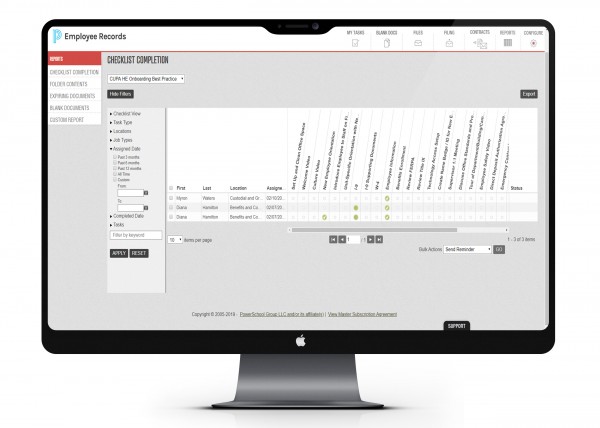The Crucial Role of Compliance in Higher Education Institutions
Onboarding new hires can be an involved process and for an institution, compliance throughout the onboarding process is of the utmost importance. With each state and institution having its own procedures, standards, and requirements, there is a great deal of paperwork and a large number of steps to complete before a new member of the faculty or staff even steps foot on campus. From background checks and I-9s, to campus ID cards and system logins, onboarding is complex and can involve multiple departments, like HR, facilities, and IT. That’s why it’s important to have processes in place to ensure that everything runs smoothly.
Onboarding and developing a faculty or staff member requires transparency, accuracy, and tracking to ensure departments, HR personas, and the applicant participate in the process simultaneously.
A Multifaceted Approach to Onboarding for Higher Education
The Society for Human Resource Management (SHRM) is an organization that offers educational resources and certifications for human resources professionals across the country. When it comes to bringing new employees into an organization, SHRM identifies four distinct crucial levels of onboarding, or the Four C’s: compliance, clarification, culture, and connection.
1. Compliance
At this level, HR teaches new employees about legal and policy-related issues. This is often the most formal and structured part of an onboarding process, including going over contracts and legal materials related to the company or to their new role, as well as discussing company policies and confidentiality rules.
2. Clarification
In the clarification stage of onboarding, HR makes sure that new employees understand their unique role and responsibilities, along with company or manager expectations. This can include examining upcoming projects, discussing work location and hours, introducing supervisors or immediate reports, explaining the performance review process, and more.
3. Culture
During this level of onboarding, HR focuses on exposing new hires to the mission, values, and norms of the organization. Helping new employees understand and embrace the culture (both formal and informal) of their new workplace is key to making them comfortable and invested in their roles. Help them see where they fit into your institution!
4. Connection
The highest level of onboarding is connection, where new employees begin building relationships with other members of their team and the broader organization. HR can support this by introducing a new hire to as many coworkers as possible, creating onboarding cohorts, encouraging formal meetups (like mentors or networking groups) and informal ones (like grabbing lunch or coffee). This may be the highest level of onboarding, but it is also fundamental, especially when some workers are remote or hybrid. HR teams must be intentional about communicating and sharing company culture so that a new employee can start feeling engaged.
At PeopleAdmin, we help you meet the mandatory compliance needs through automation and technology, freeing you up to focus on clarification, culture, and connection within your process.
Transforming Compliance with PeopleAdmin
When compliance is automated and streamlined, it can save everyone involved time, money, and effort. PeopleAdmin’s HigherEd Cloud allows your team to simplify the distribution of required documents and forms, ensuring each new hire is given the same materials, in the same way, every time. The Employee Records module was built specifically for HigherEd, and helps your team create a positive, personalized onboarding process that covers compliance, clarification, culture, and connection, while still getting the information you need. With all documents in one portal and full visibility, compliance reporting is simple and accessible.
Our intuitive reports allow for complete visibility across your organization, creating a continually simplified process with real-time analytics. Each new hire will find a standardized, consistent process standardization and consistency, while it provides HR personas and the hiring committee a seamless pain-free process.
Streamlined Onboarding with Employee Records
With the connected HigherEd Cloud, your team and every new hire can stay on track. The Employee Records module allows for all the following tasks to be completed in a workflow and electronically stores:
- Employment contracts
- Personal data forms
- HR payroll forms
- I-9 verification form
- W-4 form
- Title IX form
- Policy and Procedure documents
- Campus ID forms
- Employee handbook acknowledgment form
- Confidentiality agreement forms
- System security acknowledgment and access forms
- State-required notification forms
- Benefits and Enrollment forms
Real-time Insights
PeopleAdmin’s tools have actionable insights that support compliance and visibility for HR teams. In Employee Records, user-friendly checklists and alerts mean that both new hires and HR teams can see what’s been completed and what’s next. HR can track onboarding progress, reduce bottlenecks, and ensure new hire compliance with user-friendly reports and dashboards. Throughout the employee lifecycle, HR can oversee contract renewal, leave requests, offboarding, and more. See what forms are missing, what’s due, and what’s expiring– you’ll never have to chase down a missing form again. Compliance reporting is a breeze with standardized, real-time reporting available at a click of a button. Your institution can stay audit-ready with a historical record of all changes, approvals, and more.
Digitizing the Onboarding Lifecycle in Higher Ed Hiring
Digitizing your entire lifecycle, including onboarding, can save your university and its departments time and money. Online forms create a transparent process of form completion, allowing for one-time data entry for all parties involved. Once data is in the system, it can travel with that employee throughout their entire employee lifecycle. Digital records can be easily accessed and referenced or retrieved in case of an audit. The information is more accurate, thanks to built-in validity checks and required fields.
Data Accuracy and Accessibility
Within PeopleAdmin’s systems, data is secure and accurate. HR oversight reduces errors and inconsistencies from manual data re-entry, and admins can control who has access to what documents and information. Having all documents completed, submitted, and stored in one Employee Records portal means increased security for the sensitive information collected by HR, while less paper translates to time and cost savings. Employee Records can centralize and safely store all documents related to employee hiring and management. The system manages I-9s, W-4s, benefits information, contracts, policy forms, bio updates, tuition benefits, FMLA documents, leave requests, and more—all on-demand and paper-free.

Make Your Campus Compliant and Audit-Ready with Employee Records
Building an empowered, engaged, and competent workforce starts long before a new hire walks through your institution’s door. Make a great first impression with comprehensive onboarding processes designed to welcome new hires seamlessly with Employee Records. PeopleAdmin’s Employee Records (formerly Onboard and Records) enables higher education institutions to maintain compliance without the added stress of paper processes, freeing hiring managers and HR teams to focus on personalized communications and meaningful development-driven activities. This, paired with Applicant Tracking System (ATS), gives your institution the resources and data it needs to be successful. With Employee Records, new employees are up to speed and ready to fill their roles quickly, so they can spend more time advancing the institution’s mission.
What our on-demand webinar, Navigating HigherEd Hiring and Retention, for more!